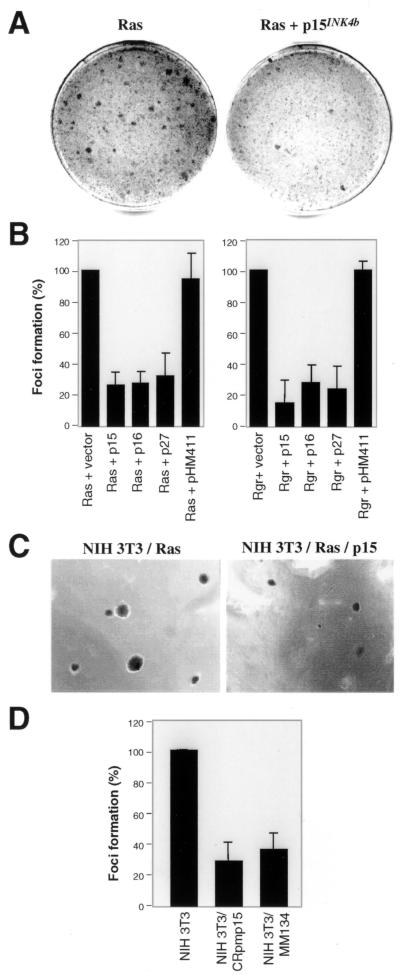FIG. 2.
Effects of several cell cycle inhibitors on NIH 3T3 cellular transformation by Ras. (A) Photograph of foci obtained after cotransfection of NIH 3T3 cells with pMZNT-17 (expressing oncogenic N-ras N61) and the empty vector pCR3.1 (left) or pMZNT-17 and pHM414 (expressing p15INK4b) (right). (B) Suppression activity of p15INK4b and other cell cycle inhibitors (p16INK4a and p27Kip1) on focus formation by Ras (left panel) or Rgr (right panel) in NIH 3T3 cells. Cells were cotransfected with pMZNT-17 (Ras) or pNM11 (Rgr) and the expression plasmid for p15INK4b, p16INK4a, or p27Kip1. The empty vector or the vector containing p15INK4b in the opposite orientation (pHM411) was used as a control. Results are represented as percentages of the number of foci obtained with Ras or Rgr and the empty vector (taken as 100%). The mean and standard error were calculated from three independent experiments. (C) Effect of p15INK4b expression on anchorage-independent growth of Ras-transformed NIH 3T3 cells. Transformed cells expressing or not expressing p15INK4b were seeded in agar-containing medium and grown for 2 weeks. The presence of this cell cycle inhibitor was accompanied by a decrease in the number and size of colonies in two separate experiments. A sample of the colonies obtained in cells expressing Ras or Ras plus p15INK4b is shown. (D) Focus formation by oncogenic Ras in NIH 3T3 cells containing a p15INK4b genomic fragment. The same number of NIH 3T3, NIH 3T3/CRpmp15, or NIH 3T3/MM134 cells was transfected with pMZNT-17, and the number of foci was scored after 15 days. Results are presented as percentages of the number of foci obtained with Ras in NIH 3T3 cells (taken as 100%). The mean and standard error were calculated from three independent experiments.

